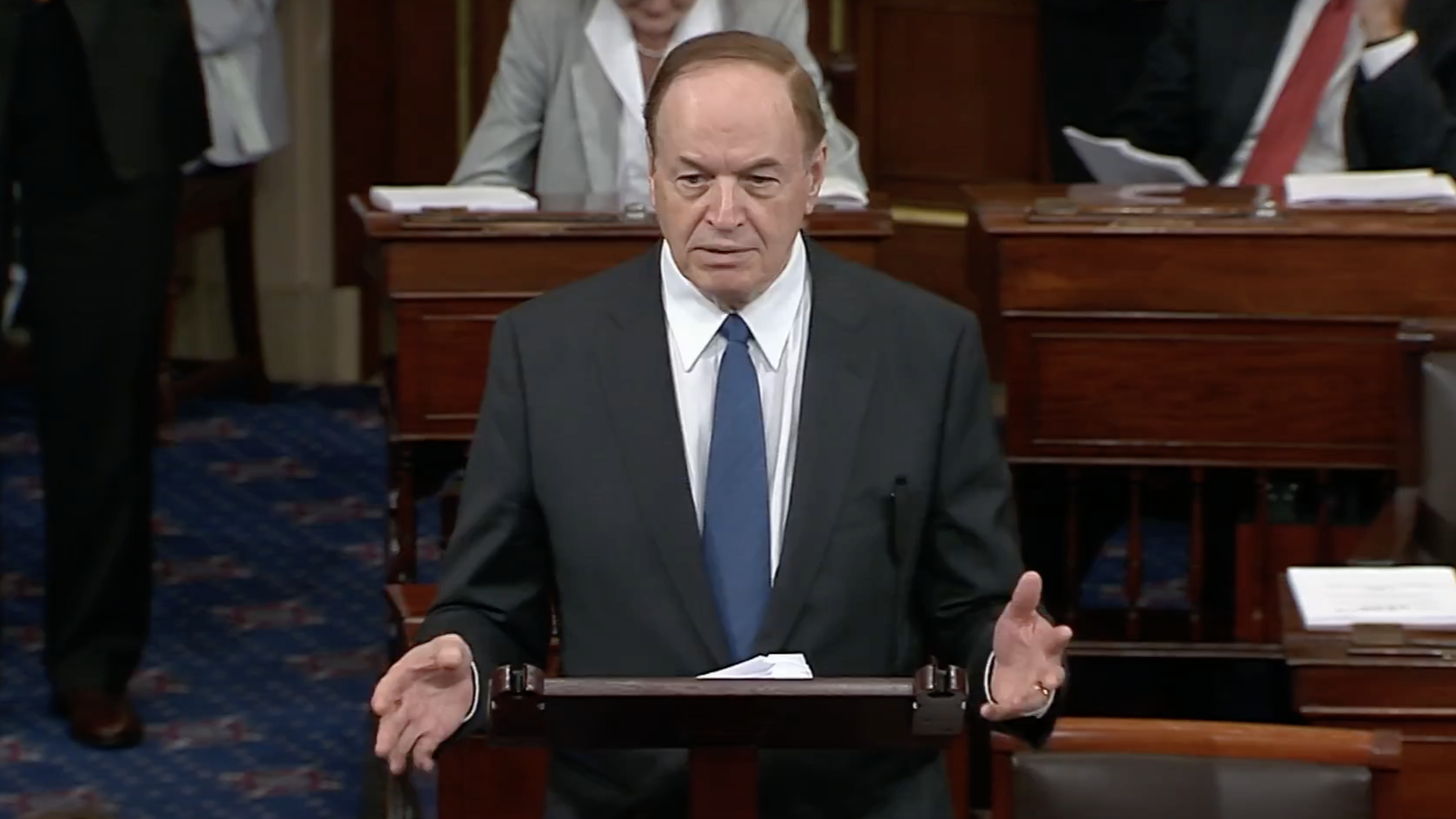Republican Alabama Sen. Richard Shelby announced Senate passage of a comprehensive appropriations package containing 12 government spending bills plus roughly $900 billion in additional COVID-19 relief for struggling Americans and businesses.
Shelby voted in favor of the legislation, the Consolidated Appropriations Act of 2021, which passed in the Senate by a vote of 92 to 6 after earlier passing in the House of Representatives. It will now head to the president’s desk for his signature.
This package will keep the U.S. government funded through the end of the 2021 fiscal year, which ends in September, while providing a coronavirus stimulus for the economy.
“This is great news,” Shelby said. “I am pleased we swiftly advanced this package through Congress and on to the president’s desk. The American people expect us to do our job, and funding the government, including the military, is our fundamental responsibility. This package not only includes FY21 appropriations bills, but it also provides COVID relief for struggling American families, workers, and businesses. This is paramount as our nation works to recover from the pandemic. This year has been unprecedented in a number of ways. Completing our work is all the more important.”
The COVID relief portion of the package includes an extension of the Paycheck Protection Program, funding for vaccine production and distribution, stimulus checks and a temporary extension of a number of unemployment programs created by the CARES Act.
The legislation also includes $7 billion for broadband development, including access to rural broadband and telehealth. A total of $13 billion is also provided to support farmers and agriculture impacted by the COVID-19 pandemic.
The appropriations package supports Alabama in the areas of defense, aerospace, medical research, agriculture and more, Shelby said.
“Alabama’s skilled workforce has a far-reaching impact on the entire nation,” Shelby said. “The funding in this appropriations package shows just that – that Alabama remains at the forefront and leads in many areas, such as missile defense, space exploration, medical research, and manufacturing, to name a few. This legislation makes certain that Alabama will remain a major player on the national stage. I look forward to its lasting influence on our state and our nation.”
The package contains a number of provisions impacting Alabama from the respective appropriations subcommittees.
From the Senate Agriculture, Rural Development, Food and Drug Administration, and Related Agencies Appropriations Subcommittee, there is $175 million for Watershed and Flood Prevention Operations, including language to exempt watershed projects that impact areas greater than 250,000 acres, which helps expand irrigation agriculture projects in Alabama.
The package provides funding to the Agricultural Research Service, which supports current research initiatives at Auburn University including:
- $4 million for aquaponics system development
- $5 million to combat cotton blue disease
- $3 million for advanced poultry production technology development
- $2 million for advancing efficiency of forage-based beef production
- $1.5 million for alternative technologies for poultry waste utilization
- $1.2 million to study harmful algal bloom impact on aquaculture
- $1 million for dietary manipulation to improve gut health in broiler production
- Maintains funding for foodborne pathogens and shrimp production research
- $1.5 million for the establishment of a center of excellence for Animal Health and Agro-Bio Defense science, which Auburn University supports through the development of the National Bio and Agro-Defense Facility
The package also contains $3 million in grant funding for the Animal and Plant Health Inspection Service to develop a new pilot program to assist statewide departments of agriculture and forestry commissions, including the Alabama Forestry Commission, in controlling the spread of cogongrass.
The package contains $1 million for the FDA to develop research, education and outreach partnerships with academic institutions to study and promote seafood safety, which will benefit ongoing research at the Dauphin Island Sea Lab.
There is $5 million for rural development to coordinate with Southeastern universities on a pilot program to develop innovative rural wastewater treatment solutions for communities with untreated sewage issues, such as the Black Belt region of Alabama.
From the Senate Commerce, Justice, Science, and Related Agencies Appropriation subcommittee:
- The Department of Commerce will provide $34.5 million to support staffing and operations at the National Water Center, which is located in Tuscaloosa.
- It funds $15 million for the establishment of a new National Oceanic and Atmospheric Administration (NOAA) Cooperative Institute to help NOAA and the National Water Center address the nation’s growing water-related challenges.
- There is $2.5 million to conduct an independent population assessment of the number of greater amberjack in the Gulf of Mexico.
- There is $7 million to ensure successful implementation of “Reef Fish Amendment 50,” which delegates the federal management of red snapper to the Gulf Coast states.
- There is also $2.6 million for the National Oceanic and Atmospheric Administration (NOAA) to implement and enforce the Seafood Import Monitoring Program.
For the Department of Justice, there is $566 million for FBI construction, which supports ongoing and growing efforts in Huntsville.
NASA receives $6.5 billion for space exploration, which includes $2.6 billion for the Space Launch System program and $850 million for the Human Landing System, both of which are managed by Marshall Space Flight Center in Huntsville and are critical to the development and sustainment of the nation’s human exploration goals.
The Army Corps of Engineers was awarded $50 million for the operations and maintenance of Donor and Energy Transfer Ports, which benefits the Port of Mobile.
There is also $5 million for the Regional Sediment Management Program, which benefits research conducted at the National Water Center in Tuscaloosa related to enhancing forecasting capabilities and coastal resilience.
The package includes $8.55 million for the Coastal Inlet Research Program, which supports collaboration with the Army Corps of Engineers and the National Water Center to address coastal resilience needs, measure coastal forces, and improve terrestrial and coastal modeling.
$6.2 million for the Army Corps of Engineers to continue research on the impact of reduced lock operations on riverine fish, which is in collaboration with Auburn University.
The Department of Energy received $25 million for EPSCoR program, which provides federal support for sustainable and competitive energy research in eligible states and territories. The legislation provides funding for the National Carbon Capture Center, which is located in Wilsonville, Alabama.
The legislation also provides $30 million for the Delta Regional Authority, including $15 million for flood control projects, basic public infrastructure development, and transportation improvements as well as $180 million for the Appalachian Regional Commission, including $55 million for the POWER Initiative that provides federal funding to help communities and regions affected by job losses in coal mining and coal power plant operations.
The Senate Interior, Environment, and Related Agencies Appropriation Subcommittee:
- $25 million for the Fish and Wildlife Service to combat Asian Carp and enhance efforts in sub-basins of the Mississippi River, which includes key areas of Alabama in the Tennessee and Cumberland basins.
- $2 million for downed timber research, which supports work conducted at Auburn University.
- A $25.5 million increase for U.S. Geological Survey Water Resources for staffing related to the Hydrologic Instrumentation facility, which is co-located at the University of Alabama.
The Labor, Health and Human Services, Education, and Related Agencies Appropriations Subcommittee:
- $42.9 billion for the National Institutes of Health (NIH), an increase of $1.25 billion above FY20 funding level. This funding will help increase and build on the $350 million that Alabama universities received in FY20 for medical research.
- $6.56 billion for the National Cancer Institute (NCI), an increase of $119.4 million from FY20. $45 million to the National Institute on Minority Health and Health Disparities (NIHMD) for chronic disease centers, which supports research at the University of Alabama at Birmingham (UAB).
- $855.4 million for the National Center for Advancing Translational Sciences (NCATS), an increase of $22.5 million.
- $586.8 million for Clinical and Translational Science Awards (CTSAs), an increase of $18.8 million from FY20, which continues funding for a $50 million CTSA award at UAB.
- $10 million in grant funding for Regional Pediatric Pandemic Network for Children’s Hospitals.
- $40 million in targeted funding for Regional Biocontainment Laboratories to test FDA-approved drugs.
- $1.68 billion in funding for Community Health Centers, an increase of $57.3 million, which will help fund 126 community health centers in rural areas across Alabama.
- $350 million in grant funding for Children’s Hospitals Graduate Medical Education, an increase of $10 million, which will increase Pediatric residencies at Children’s & Women’s Hospital in Mobile and Children’s of Alabama in Birmingham.
- $24.8 million for Poison Control Centers, an increase of $2 million, which supports Alabama’s Poison Control Center located in Birmingham and is affiliated with Children’s of Alabama.
The legislation also provides $35 million in continued funding for Department of Labor Workforce Opportunities in the Delta Regional Authority and Appalachian Regional Commission regions, an increase of $5 million, which funds workforce development initiatives throughout the state.
Congress also provided $185 million for industry recognized apprenticeship grants, an increase of $10 million, allowing Alabama’s Community College system the ability to tailor programs directly with employers for enhanced training and certifications.
The is also $440 million in federal money for charter schools, which continues to fund University Charter School in Livingston, Alabama, and could potentially expand charter schools throughout the state of Alabama.
The Transportation, Housing and Urban Development, and Related Agencies Appropriations subcommmittee:
- $30 million for Alabama’s Northern Beltline of the Appalachian Development Highway System.
- $1 billion for the Better Utilizing Investments to Leverage Development (BUILD) grant program, which provides federal investment to support road, rail, transit, and port projects.
- $1 billion for the INFRA grant program, which provides federal funding for highway and freight projects of national and regional significance.
- $18 billion for the Federal Aviation Administration (FAA), which provides assistance for Alabama airports, including grants-in-aid for airports, contract towers, research for advanced materials and structural safety, research on airfield pavement, and aviation workforce grants.
The Senate Appropriations Subcommittee on Defense / Homeland Security / Military Construction, Veterans Affairs, and Related Agencies had a number of measures impacting Alabama.
Impacting the Wiregrass region:
- $1.2 billion for flight training at Fort Rucker to address the Army pilot shortage.
- $717.9 million for Future Vertical Lift research, which will accelerate the development of helicopters flown at Fort Rucker, and an additional $90.5 million to accelerate the Future Long Range Assault Aircraft.
- $48 million for United States Coast Guard MH-60T sustainment.
- $131 million to upgrade the MH-60 series helicopters.
- $578 million for Terminal High Altitude Area Defense (THAAD) missiles.
- $196 million for Joint Air-to-Ground Missiles (JAGMs).
- $470 million for Joint Air-Surface Standoff Missile (JASSMs) and $134 million for Long Range Anti-Ship Missiles (LRASMs).
- $91 million for Hellfire missiles, which are made in Troy and used for training at Fort Rucker.
- $200 million for Javelin missiles for the Army and Marine Corps.
Impacting North Alabama:
- Army Research – $13.9 billion, an increase of $1.4 billion from FY20, for investments in transformational technologies to address modern and future Army warfighting needs.
- Missile Defense – $10.46 billion for the Missile Defense Agency (MDA), which is located in Huntsville, to ensure support for urgent MDA unfunded priorities such as space sensors, hypersonic defense, and cybersecurity.
- Hypersonic weapons – fully funds Army hypersonic research, which is an increase of $461.4 million above the FY20 enacted level, as well as an additional $60 million to develop a common hypersonic glide body and $47 million to advance hypersonic testing infrastructure.
- Cyber – $430 million to support the Department of Defense’s 5G program.
Impacting Anniston:
- $19 million for Federal Emergency Management Agency’s (FEMA) Center for Domestic Preparedness for capital improvements and infrastructure modernization, including $10.6 million for high-priority maintenance and operational requirements for the Federal Incident Workforce Academy.
- $125 million for Hydra rockets, which are built in Anniston and fired from Army and Marine Corps helicopters.
- Funding for Army vehicles overhauled and maintained at Anniston Army Depot (ANAD), including: $968 million to continue upgrading and modernizing the M1 Abrams tanks; $1.1 billion for Stryker vehicle upgrades; $463 million for Paladin Integrated Management artillery vehicles; and $188 million for a Demilitarization Facility at the Anniston Army Depot.
Impacting Mobile’s shipbuilding industry:
- One additional Expeditionary Fast Transport (EPF) ship with increased medical capabilities
- $50 million to explore autonomous proficiencies for existing EPF ships
- An additional $500 million for LHA-9, an amphibious assault ship
Other miscellaneous items include:
- $11.6 million for a new F-35 Simulator Facility at Montgomery Regional Airport Base
- $34 million for the Secret Service’s National Computer Forensics Institute, located in Hoover, to expand training opportunities for state and local law enforcement and legal and judicial professionals in computer forensics and cyber investigations
- $15 million for the Department of Homeland Security’s Explosive Detection Canine Program, which was developed in collaboration with Auburn University
Shelby is the chairman of the Senate Appropriations Committee and its subcommittee on defense.
The bill now goes to President Donald Trump, who is expected to sign it.





















































